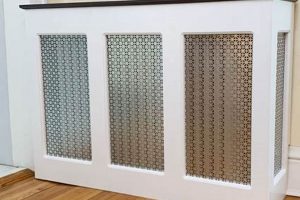Personalized smartphone protection can be achieved through crafting customized enclosures. These individualized covers are often created using readily available materials and simple techniques, allowing for unique designs and personal expression. For example, one might utilize adhesive decorations, paint, or repurposed fabrics to alter a plain, commercially available phone case.
The creation of these custom accessories offers several advantages, including cost-effectiveness and aesthetic control. Individuals can save money by avoiding expensive retail options and can tailor the case’s appearance to their specific preferences. This practice also fosters creativity and resourcefulness, promoting sustainable practices by repurposing existing items. Historically, the desire for personalization has driven individuals to modify and embellish everyday objects, and this trend extends to the contemporary practice of decorating mobile device housings.
The subsequent sections will explore various approaches to constructing bespoke mobile device covers, considering material selection, design considerations, and practical application techniques. These discussions will provide a comprehensive overview of how to effectively and creatively produce personalized smartphone protection.
DIY Phone Case Construction
The successful creation of a custom smartphone enclosure requires careful planning and execution. The following guidelines aim to provide practical advice for achieving a durable and aesthetically pleasing result.
Tip 1: Material Selection is Critical: Choose materials appropriate for the intended use and aesthetic. Rigid plastics offer superior impact resistance, while flexible materials provide better grip. Ensure the selected material is compatible with adhesives and paints, if applicable.
Tip 2: Surface Preparation is Paramount: Before applying any decorative elements, thoroughly clean the surface of the existing case with isopropyl alcohol. This removes oils and debris, ensuring proper adhesion.
Tip 3: Design Simplicity Enhances Durability: Avoid overly intricate designs that may be prone to damage or detachment. Opt for clean lines and geometric patterns for increased longevity.
Tip 4: Adhesive Application Requires Precision: When using adhesives, apply them sparingly and evenly. Excess adhesive can seep out and create a messy finish. Allow sufficient drying time according to the manufacturer’s instructions.
Tip 5: Sealing Protects the Finished Product: Apply a clear sealant or varnish over the completed design. This provides a protective layer against scratches, moisture, and UV damage.
Tip 6: Template Use Ensures Accuracy: Employ templates or stencils when applying complex designs. This helps maintain consistent spacing and prevents errors.
Tip 7: Edge Finishing Improves Aesthetics and Comfort: Pay attention to the edges of the case. Sanding or filing down any rough edges ensures a comfortable grip and a professional appearance.
Adhering to these guidelines can significantly improve the quality and durability of the finished product. These strategies promote a balance between aesthetic expression and functional reliability.
The following sections will delve into specific design styles and advanced construction techniques to further enhance customization capabilities.
1. Material Durability
Material durability is a paramount consideration in the creation of do-it-yourself (DIY) phone cases. The selection of materials directly influences the level of protection afforded to the device and the overall lifespan of the customized enclosure. A substandard material compromises the case’s ability to withstand everyday wear and tear, potentially leading to device damage.
- Impact Resistance
Impact resistance quantifies a material’s capacity to absorb and dissipate energy from sudden impacts. A material with high impact resistance, such as polycarbonate or thermoplastic polyurethane (TPU), will better protect the phone from damage resulting from drops or collisions. Conversely, materials like brittle plastics or thin cardboard offer negligible impact resistance and are unsuitable for providing adequate protection.
- Scratch Resistance
Scratch resistance refers to a material’s ability to withstand surface abrasion. Materials with poor scratch resistance, such as soft plastics or painted surfaces without a protective coating, will readily exhibit scratches and cosmetic damage, diminishing the aesthetic appeal of the DIY phone case over time. Harder materials, like treated metals or scratch-resistant coatings, offer enhanced protection against everyday abrasions.
- Environmental Degradation Resistance
Environmental degradation encompasses the effects of sunlight, moisture, and temperature fluctuations on the structural integrity of the material. Materials susceptible to UV degradation may become brittle, discolored, or weakened over time, compromising the phone case’s protective capabilities. Similarly, materials prone to moisture absorption can warp or degrade, reducing their effectiveness. Choosing materials with inherent resistance to environmental factors, or applying protective coatings, can mitigate these issues.
- Flexibility and Fatigue Resistance
Flexibility allows a phone case to absorb some impact by deforming. Fatigue resistance is a material’s ability to withstand repeated stress or flexing without failing. Flexible materials with poor fatigue resistance will crack and degrade after extended use. Materials like silicone can exhibit good flexibility and impact absorption, but may degrade with repetitive bending. Proper material selection considers both immediate impact protection and long-term resilience to repeated stress.
The interplay of these factors is crucial in determining the long-term effectiveness of a DIY phone case. Opting for durable materials appropriate to the anticipated use environment, coupled with careful construction techniques, is essential for creating a protective and aesthetically pleasing accessory that extends the lifespan of the enclosed device.
2. Design Complexity
Design complexity in the context of DIY phone cases refers to the intricacy and detail of the decorative elements or structural modifications incorporated into the case. Higher complexity designs often involve multiple layers, intricate patterns, or modifications to the case’s original form. The level of complexity directly impacts the time, skill, and resources required for completion, as well as the potential durability and functionality of the finished product. For example, a simple design might involve applying adhesive vinyl stickers to a plain case, while a complex design could entail sculpting a custom three-dimensional shape using polymer clay or integrating ele
ctronic components.
The decision to pursue a simple or complex design carries significant implications. A simpler design is generally more accessible to individuals with limited crafting experience and reduces the risk of errors or structural failures. However, the aesthetic outcome may be less visually striking or personalized. Conversely, a complex design offers the potential for a highly unique and personalized phone case, reflecting individual artistic expression. A complex project presents challenges related to precise execution, material compatibility, and structural integrity. For instance, a case incorporating multiple small, delicate elements may be more susceptible to damage from everyday use than a case with a single, robust design. A real-life example of a complex design is the creation of a phone case that mimics a miniature terrarium, complete with resin casting, artificial plants, and internal lighting. Such projects demand advanced skills and careful attention to detail.
The practical significance of understanding design complexity lies in the ability to make informed decisions regarding project feasibility and resource allocation. A realistic assessment of one’s skills and available tools, alongside a careful consideration of the desired aesthetic and functional requirements, is crucial for selecting a design that aligns with personal capabilities and project goals. Balancing creativity with practicality ensures a satisfying DIY experience and a durable, functional phone case. Ignoring these considerations can lead to frustration, wasted resources, and ultimately, a substandard final product.
3. Adhesive Strength
Adhesive strength represents a critical parameter in the construction of do-it-yourself phone cases. The efficacy of the adhesive used directly influences the structural integrity and long-term durability of the customized enclosure, impacting its ability to withstand daily use and protect the enclosed device.
- Surface Compatibility
The type of material used for the case and any decorative elements directly dictates the appropriate adhesive. Certain adhesives bond effectively with plastics, while others are better suited for fabrics, metals, or glass. Incompatibility leads to weak adhesion and eventual detachment. For instance, cyanoacrylate adhesives (super glue) generally bond well with plastics, but may not be suitable for flexible materials like silicone. Selecting an adhesive formulated for the specific materials involved is paramount.
- Shear Strength
Shear strength measures the adhesive’s resistance to forces applied parallel to the bonded surface. In a phone case, this is relevant when the case is subjected to stress from being placed in a pocket or bag, or from accidental bumps. A high shear strength adhesive resists this sliding force, preventing elements from shifting or detaching. Epoxy adhesives, for example, generally exhibit high shear strength compared to weaker alternatives like craft glues.
- Tensile Strength
Tensile strength assesses the adhesive’s ability to withstand forces pulling directly away from the bonded surfaces. This is important for decorative elements that may experience outward pressure or force. Low tensile strength adhesives will result in elements peeling away easily. For example, when attaching a large embellishment to a phone case, a robust adhesive with high tensile strength, such as a specialized polymer adhesive, is necessary to ensure a secure bond.
- Environmental Resistance
Adhesive properties can be significantly affected by environmental factors, including temperature, humidity, and UV exposure. Adhesives that degrade under these conditions will lose their bonding strength over time. Outdoor phone cases, or those frequently exposed to sunlight, require adhesives with high environmental resistance. Certain epoxy formulations and specialized UV-resistant adhesives are designed to maintain their integrity under harsh conditions.
Ultimately, the selection and application of appropriate adhesives are fundamental to the successful creation of durable and aesthetically pleasing DIY phone cases. Failure to address the various aspects of adhesive strength leads to compromised functionality and premature failure of the customized enclosure.
4. Surface Preparation
Effective surface preparation is a foundational element in the creation of durable and visually appealing do-it-yourself phone cases. The adhesion of paints, embellishments, and protective coatings hinges upon a properly prepared surface, directly impacting the longevity and aesthetic quality of the final product.
- Cleaning and Degreasing
The removal of contaminants such as oils, dirt, and fingerprints is a critical initial step. These substances interfere with adhesive bonding, leading to premature peeling or bubbling of applied materials. Isopropyl alcohol is often employed as a cleaning agent due to its ability to dissolve oils and its rapid evaporation, leaving a clean and receptive surface. For instance, failing to remove residual oils from a plastic case before applying adhesive vinyl decals will likely result in the decals lifting at the edges over time.
- Abrasive Treatment
Certain surfaces, particularly smooth plastics, benefit from light abrasion to create microscopic irregularities. These irregularities increase the surface area available for adhesive bonding, resulting in a stronger and more durable bond. Fine-grit sandpaper or steel wool can be used to gently roughen the surface without causing significant damage. For example, lightly sanding a glossy plastic phone case before painting enhances the paint’s adhesion and prevents chipping.
- Priming
Priming involves the application of a specialized coating designed to improve the adhesion of subsequent layers of paint or other decorative materials. Primers create a uniform and receptive surface, particularly on porous or non-ideal materials. For instance, applying a plastic-specific primer to a bare plastic case before painting ensures that the paint adheres evenly and resists peeling or scratching.
- Dust Removal
The presence of dust particles on the surface can compromise the smoothness and integrity of the final finish. Dust interferes with adhesive bonding and can create visible imperfections in painted or coated surfaces. A tack cloth or compressed air can be used to effectively remove dust particles prior to applying decorative or protective layers. For example, failing to remove dust before applying a clear coat to a painted phone case can result in a rough and uneven finish.
In summary, meticulous surface preparation is essential for achieving professional-looking and long-lasting do-it-yourself phone cases. By addressing potential adhesion issues through cleaning, abrasion, priming, and dust removal, the durability and aesthetic appeal of the final product are significantly enhanced.
5. Protective Coating
The application of a protective coating is a crucial step in the creation of durable and visually appealing do-it
-yourself (DIY) phone cases. Such coatings serve as a barrier against a range of environmental factors and physical stresses that can degrade the appearance and integrity of the underlying materials.
- Scratch Resistance Enhancement
Protective coatings, such as clear acrylic lacquers or polyurethane varnishes, significantly enhance a DIY phone case’s resistance to scratches and abrasions. These coatings form a hard, durable layer that shields the decorated surface from keys, coins, and other objects encountered in daily use. For instance, a phone case adorned with painted designs and then coated with a clear epoxy resin exhibits superior scratch resistance compared to an uncoated case, preserving the artwork’s vibrancy and clarity over time.
- UV Damage Mitigation
Prolonged exposure to ultraviolet (UV) radiation can cause fading, discoloration, and degradation of many materials commonly used in DIY phone case designs, including paints, inks, and certain plastics. Protective coatings formulated with UV inhibitors act as a shield, absorbing or reflecting harmful UV rays and preventing them from reaching the underlying materials. A phone case decorated with vibrant fabric and sealed with a UV-resistant acrylic spray will retain its color and structural integrity for a longer duration than an unprotected counterpart.
- Moisture and Chemical Barrier
Protective coatings provide a barrier against moisture, spills, and exposure to chemicals such as cleaning solutions or hand sanitizers. These substances can damage or discolor decorative elements, or compromise the adhesive bonds holding the case together. A phone case embellished with paper decoupage and sealed with a waterproof varnish will resist water damage and maintain its aesthetic appeal even when exposed to damp conditions.
- Improved Cleanability
Textured or porous surfaces on DIY phone cases can accumulate dirt and grime, making them difficult to clean. Protective coatings create a smooth, non-porous surface that is easy to wipe down and sanitize. A phone case decorated with textured polymer clay and coated with a clear sealant will be easier to clean and maintain compared to an unsealed case, preserving its hygiene and appearance.
In conclusion, the selection and application of an appropriate protective coating is a critical consideration for DIY phone case creators seeking to enhance the durability, longevity, and aesthetic appeal of their designs. Protective coating will keep phone cases looking great. By providing a shield against scratches, UV radiation, moisture, chemicals, and dirt, these coatings safeguard the investment of time and effort involved in crafting personalized smartphone accessories.
6. Edge Finishing
Edge finishing, in the context of do-it-yourself (DIY) phone cases, refers to the process of refining and treating the edges of the case to enhance its comfort, appearance, and durability. This process is often overlooked but is crucial for creating a professional-looking and functional product.
- Comfort Enhancement
Sharp or rough edges can cause discomfort during handling and prolonged use. Edge finishing techniques, such as sanding or filing, smooth these imperfections, preventing irritation and improving the overall user experience. For example, a 3D-printed phone case with unfinished edges may feel abrasive against the skin, whereas a case with sanded and polished edges will be more comfortable to hold. This tactile improvement is a significant benefit of proper edge finishing.
- Aesthetic Refinement
Well-finished edges contribute significantly to the overall aesthetic appeal of a DIY phone case. Rounded or beveled edges create a more refined and professional look, elevating the perceived quality of the product. Consider a DIY phone case made from laser-cut wood; unfinished edges would appear raw and unpolished, whereas edges that have been carefully sanded and stained would impart a sense of craftsmanship and attention to detail.
- Durability Improvement
Unfinished edges are often more susceptible to chipping, cracking, or delamination, particularly in cases made from layered materials. Edge finishing techniques, such as sealing or coating, can protect the edges from moisture, impact, and abrasion, extending the lifespan of the case. For instance, a DIY phone case constructed from multiple layers of cardboard will quickly degrade if the edges are left exposed to moisture; sealing the edges with varnish or epoxy will provide a protective barrier.
- Functional Integration
Edge finishing can also facilitate the integration of functional elements, such as buttons, ports, or grips. Precisely shaped and finished edges ensure that these elements fit seamlessly with the case, enhancing usability and preventing damage. For example, a DIY phone case with poorly finished edges might obstruct access to the charging port or cause buttons to stick; careful edge finishing ensures smooth operation and prevents interference.
In summary, edge finishing is a multifaceted process that contributes significantly to the comfort, aesthetic appeal, durability, and functionality of DIY phone cases. Neglecting this aspect can result in a product that is uncomfortable, unattractive, and prone to damage, while careful attention to edge finishing elevates the quality and user experience.
Frequently Asked Questions About DIY Phone Cases
This section addresses common inquiries concerning the creation and maintenance of custom smartphone enclosures, providing informative responses to ensure project success.
Question 1: What material offers the best balance of protection and ease of customization?
Thermoplastic polyurethane (TPU) provides a favorable combination of impact resistance, flexibility, and paint adhesion. This material is relatively easy to work with and offers adequate protection against everyday wear and tear.
Question 2: How can air bubbles be prevented when applying adhesive materials?
Employing a squeegee or similar smooth, flat tool can effectively eliminate air bubbles during application. Applying gentle, even pressure from the center outwards ensures a smooth, bubble-free finish. Careful surface preparation is also crucial.
Question 3: What type of sealant is recommended for protecting painted designs?
A clear acrylic lacquer or polyurethane varnish is generally recommended. These sealants provide a durable, scratch-resistant layer that protects the painted design from damage and UV exposure. Ensure compatibility with the underlying paint.
Question 4: How should edges be finished for a professional look and comfortable grip?
Fine-grit sandpaper or a specialized edge-rounding tool can be used to smooth and round sharp edges. Subsequent polishing with a soft cloth enhances the comfort and aesthetic appeal of the finished case.
Question 5: Is it possible to incorporate electronic components into custom phone cases?
Yes, it is feasible to integrate electronic components such as LEDs or small displays. However, this requires advanced technical skills and a thorough understanding of electrical safety. Careful planning and execution are essential to avoid damage to the phone or injury.
Question 6: How can I ensure that my design is original and does not infringe on intellectual property rights?
Thorough research is crucial. Avoid incorporating trademarked logos, copyrighted images, or protected designs without obtaining explicit permission from the rights holder. Creating entirely original artwork is the safest approach.
These answers offer practical guidance for common challenges encountered in DIY phone case creation. Careful attention to these details will contribute to a successful and satisfying project outcome.
The following section will delve into case designs and creative ideas.
Conclusion
This exploration of DIY phone cases has illuminated various aspects of their creation, from material selection and design complexity to adhesive strength, surface preparation, protective coatings, and edge finishing. The discussions have highlighted the importance of each factor in achieving a durable, aesthetically pleasing, and functional result. Successful creation demands careful planning, skilled execution, and a thorough understanding of the materials and techniques involved.
The increasing desire for personalization, coupled with readily accessible materials and techniques, ensures that the pursuit of custom-designed smartphone protection will continue to thrive. The potential for creative expression is virtually limitless. The commitment to quality and thoughtful design, however, remains paramount to achieving lasting value and satisfaction from these personalized accessories.






![DIY Build: Circular Saw Crosscut Jig PDF Plans [Free] The DIY Hub: Creative Crafts, Repairs & Life Hacks DIY Build: Circular Saw Crosscut Jig PDF Plans [Free] | The DIY Hub: Creative Crafts, Repairs & Life Hacks](https://craftingdiycenter.com/wp-content/uploads/2025/07/th-5916-300x200.jpg)
